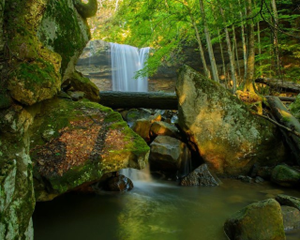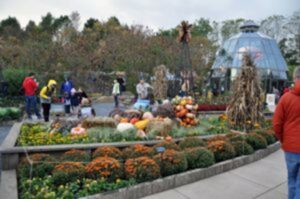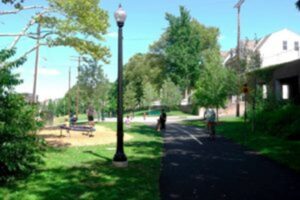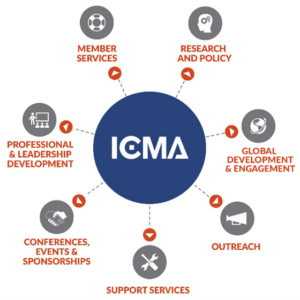The Latest News from PA Chapter of APA…
It’s summertime, which means it’s time to get out and about to explore Pennsylvania’s many great parks, trails, woodlands, and historic sites. One of the unsung stories of the past 20 to 30 years is the profusion of new and improved parks, trails, and nature preserves added to our ever-growing inventory. Often, these have been smaller-scale local projects rather than the big state and federal preservation successes that occurred in prior decades. But they add up, and planners have been at the forefront of these efforts. This month, we celebrate many of these successes, including the Mifflin House in York County, the Ohiopyle multimodal gateway project, the Arboretum at Penn State, the South Bethlehem Greenway, and Jim Dietrich Park in Berks County. We also highlight two organizations related to these efforts: the America250PA Commission and the International City/County Management Association. Enjoy!
Telling Your Story: Effective Strategies for Communication
Next Webinar Wednesday is Wednesday, August 3 starting at noon. Successful public communication is more than surveys and opinion polls. It must also inform and educate, and that requires more than posting everything on your website. Even in a small community, that volume of data is overwhelming and can be frustrating to navigate. In this presentation, we will share how West Whiteland Township created the “Development by Design” brand and integrated it into their communications to organize a high volume of information during a period of rapid development, helping residents stay informed about what was happening in the Township while assuring them that all of this was, in fact, planned.
CM credit is pending approval. Deadline to register is August 2, 2022
If you’re interested in sponsoring a Webinar Wednesday session or have a session for Webinar Wednesday, please contact us. Send your request to info@planningpa.org.
APA PA Annual Conference: Become a Sponsor
This year’s conference, “Forging Ahead: Adapting to Change!” takes place October 2-4 2022. The Annual Conference provides a unique and effective opportunity to showcase your work and capabilities to planning professionals and policy makers from across the Commonwealth. It’s also one of the ways to support planning in Pennsylvania by providing valuable networking, education, and development for planners.
Check out the marketing opportunity that best suits your needs. More information here.
Each year the Chapter offers a scholarship to support individuals seeking funds for academic degree programs, internships, and professional development activities. If anyone would like to contribute to the Chapter’s Scholarship fund, donations can be made here. We accept all major credit cards, or you can send a check. Please make your check payable to “PA Chapter of APA Scholarship Fund” and mail it to P.O. Box 4680, Harrisburg PA 17111.
Preserving the Underground Railroad in York County
It’s unfortunate but true: those who plan for historic resources are often braced for bad news. This month, however, we’re diving into a recent York County success.

The Mifflin House in the fall of 2019, as preservationists worked to save it
In 1800, the locally prominent Mifflin family built an estate called Hybla on a rise above the banks of the Susquehanna River, just outside of Wrightsville in York County. With their Quaker abolitionist beliefs and the home’s strategic location, it is no surprise that the Mifflins soon began to work with Robert Loney and other formerly enslaved and free blacks living in Wrightsville and Columbia to secretly transport people seeking freedom across the river. For decades, the house remained an active station on what would become known as the Underground Railroad. During the U.S. Civil War, the home and surrounding farm saw skirmishes that culminated in the burning of the nearby Columbia-Wrightsville covered bridge. With no way to cross the mile-wide river, Confederate forces instead swung westward, where an intense battle around Gettysburg, Pennsylvania, was fought a few days later.

Industrial development lies just to the west, across a small cornfield
After the Civil War, history more or less left Hybla, now known as the Mifflin House, behind. Growth and development, however, did not. In the 1960s, a new highway-style roadbed for U.S. Route 30 was constructed just north of the farm. An exit was built just to the west. At some point, the farm and much of the surrounding land was zoned industrial. Lots were developed one by one over the years and a small business park took shape adjacent to the 87-acre property. It was only a matter of time until development of the Mifflin House property would occur.

The Mifflin House remains a working agricultural property
In 2015 or so, the owners of the Mifflin House, a local family, were in negotiations with a buyer who proposed to demolish the house and outbuildings, flatten the topography, and construct warehouses. A development plan was submitted to Hellam Township, whose regulations required only that the local preservation society provide advisory comments. A grassroots effort gained momentum, but the home’s future looked grim. In 2017, Preservation Pennsylvania placed the home on its PA At-Risk list, a designation given to very few properties
In 2019, preservationists obtained a two-year delay of the sale. A variety of historically sensitive uses were explored. Plans came and went. Even a mini casino was on the table (it went into the ailing Galleria Mall a few exits west instead). The COVID-19 pandemic emerged and evolved. And finally, a financing plan came together: the nonprofit Conservation Fund purchased the property for $5.5M in May and will hold it, while the Susquehanna National Heritage Area finalizes the complex mix of state, county, and private funds it needs to become the final owner.
In May 2022, the Mifflin House was considered saved by Preservation PA. While this is unarguably good news for everyone, it couldn’t have happened without the commitment of cross-sector partners locally, regionally, and nationally. Despite a community where residents, regulators, the owners, and even the developer were inclined to support the property’s preservation, the process took more than five years and required significant amounts of time, money, and social and political capital spent in advocacy and planning. The future is bright, however. Susquehanna Heritage plans to restore the buildings and open the entire property to the public, reimagined as a regional draw for tourists that that will serve as a gateway to the historical significance underfoot as well as the many other cultural and natural resources nearby.
Celebrating the Nation’s 250th Birthday!
Although the nation’s 250th birthday is still four years away, there isn’t a lot of time to get ready for this important anniversary. Many counties around the Commonwealth, as well as the state itself, have started planning for the celebration and are already holding meetings and events. One of the first questions everyone must answer is: what the heck do we call the 250th anniversary? The term for 200 years, bicentennial, was easy! It ends up that the right term is semiquincentennial, which certainly is a mouthful and means half of a 500th anniversary.
This time around, the focus won’t just be on the events in 1776 but will feature the nation’s whole history and all members of our diverse and great nation. And events won’t just be held on July 4, 2026 but will be held throughout the coming years, including outreach to communities not normally involved in the past.
One current activity being featured by America250PA is a Bells across PA event, where artists prepare celebratory bells in every county in the commonwealth. More information about this program and other efforts of the state’s commission can be found online.
Ohiopyle Multimodal Gateway Project
Ohiopyle State Park is located in Fayette County and encompasses over 20,000 acres of rugged natural beauty including several waterfalls. Located at the gateway to the Laurel Highlands, Ohiopyle State Park attracts millions of visitors each year.
 Ohiopyle Borough is surrounded by the state park. In 2010, the borough developed a Joint Master Plan and Implementation Strategy. The plan identified the need to reduce conflicts between vehicles, pedestrians, cyclists and boat renters traversing State Route 381 within the borough.
Ohiopyle Borough is surrounded by the state park. In 2010, the borough developed a Joint Master Plan and Implementation Strategy. The plan identified the need to reduce conflicts between vehicles, pedestrians, cyclists and boat renters traversing State Route 381 within the borough.
Through a partnership between Ohiopyle Borough, Pennsylvania Department of Transportation (PennDOT), and the Pennsylvania Department of Conservation and Natural Resources (DCNR), the Ohiopyle Multimodal Gateway Project was developed. The $12 million project involved improving parking and pedestrian access on State Route 381; reconstruction of the existing parking area to the south of the Borough of Ohiopyle and east of State Route 381 to improve flow through the parking lot and increase the number of parking spaces; construction of a new pedestrian underpass from the redesigned parking area to the park’s Visitor’s Center area; and replacement of a superstructure on the existing State Route 381 bridge over the Youghiogheny River.
Construction of the Ohiopyle Multimodal Gateway Project began in 2018 was completed in 2020. The Ohiopyle Multimodal Gateway Project was the recipient of a regional America’s Transportation Award from the American Association of State Highway and Transportation Officials (AASHTO). To learn more about Ohiopyle State Park online.
Great Places Award Winner: The Arboretum at Penn State (2020)
Penn State’s Trustees originally set aside 25 acres of land adjacent to University Park Campus for the Arboretum in 1914. However, a master site plan was not completed until 1999 when the site had expanded to 370 acres. The  planning process involved community input through a series of brainstorming sessions. Today, the Arboretum, which opened in 2009, preserves a rare remnant of old-growth oak-pine forest, protects the aquifer supplying most of the campus water needs, and boasts a variety of botanical gardens, wildlife sculptures, a children’s garden, a pollinator/bird garden, and a bike trail. The property is easily accessible by residents of adjoining neighborhoods, as well as the University community, and is a popular destination for visitors. The Arboretum is home to a variety of festivals, exhibits, and programs and serves as an attractive venue for many private gatherings. It continues to evolve with planning and community involvement playing an important role to maintain this local jewel as a showcase for preserving and caring for nature. Go to the Arboretum’s website for more information.
planning process involved community input through a series of brainstorming sessions. Today, the Arboretum, which opened in 2009, preserves a rare remnant of old-growth oak-pine forest, protects the aquifer supplying most of the campus water needs, and boasts a variety of botanical gardens, wildlife sculptures, a children’s garden, a pollinator/bird garden, and a bike trail. The property is easily accessible by residents of adjoining neighborhoods, as well as the University community, and is a popular destination for visitors. The Arboretum is home to a variety of festivals, exhibits, and programs and serves as an attractive venue for many private gatherings. It continues to evolve with planning and community involvement playing an important role to maintain this local jewel as a showcase for preserving and caring for nature. Go to the Arboretum’s website for more information.
Great Places Award Winner for Transformation: South Bethlehem Greenway (2019)
The strip of land that became the South Bethlehem Greenway was originally part of a thriving passenger and industrial freight line corridor. However, with the demise of rail use following the closure of Bethlehem Steel in the mid-1990’s, the corridor became a community eyesore. With a vision to eradicate the blight, spur economic activity, and create opportunities for recreation, the City of Bethlehem stepped up to the plate, acquired the land, and developed the South Bethlehem Greenway Master Plan. An extensive planning process, with considerable public and stakeholder input, culminated with adoption of the Plan in 2005. Implementation of the plan evolved through many public-private partnerships, financial investment, and community support. These efforts resulted in a vibrant linear park that has had a robust positive impact on the community. It features a walking/biking trail, connections to adjacent neighborhoods, a community garden, public art, and a skate plaza at the eastern end. The greenway is also host to an array of events that attract many residents and visitors. Additionally, this amenity has triggered investment in, and revitalization of, neighboring properties and beyond. The South Bethlehem Greenway clearly demonstrates how many years of planning, collaboration, and strategic thinking can result in transforming a once-blighted and underutilized space into a cherished community asset and economic development driver. More information online.
developed the South Bethlehem Greenway Master Plan. An extensive planning process, with considerable public and stakeholder input, culminated with adoption of the Plan in 2005. Implementation of the plan evolved through many public-private partnerships, financial investment, and community support. These efforts resulted in a vibrant linear park that has had a robust positive impact on the community. It features a walking/biking trail, connections to adjacent neighborhoods, a community garden, public art, and a skate plaza at the eastern end. The greenway is also host to an array of events that attract many residents and visitors. Additionally, this amenity has triggered investment in, and revitalization of, neighboring properties and beyond. The South Bethlehem Greenway clearly demonstrates how many years of planning, collaboration, and strategic thinking can result in transforming a once-blighted and underutilized space into a cherished community asset and economic development driver. More information online.
Place in Planning: Great Public Space 2021 Award Winner
Jim Dietrich Park in Muhlenberg Township, Berks County
Jim Dietrich Park in Muhlenberg Township, Berks County, consisting of 109 acres and bordered by the Schuylkill River, was originally a working farm. The Township purchased the land from the Dietrich family, who wanted it developed for recreation in honor of their son. A Master Site Plan, completed in 2007, has been guiding development of the park, while also protecting its natural resources. Today, enhancements include pavilions, sports fields/courts, a dog park, water trail landings, and parking areas. The landing areas provide canoers, kayakers, and others with access to the Schuylkill River Water Trail. Jim Dietrich Park is heavily used for both active and passive recreation. The park has become a central community gathering place for the township, with a wide range of events and activities, such as a concert series, a Rotary wine and dine dinner, and ongoing yoga classes.
Planning and Managing Municipalities: A Spotlight on ICMA
Municipal management becomes more critical by the day, and planners have a key role in advocating for the importance of quality leadership in our communities. In fact, more and more planners find themselves in the role of municipal manager, where they face some challenges the profession has prepared them for, and perhaps some it hasn’t.
Whether you’re a planner who sees the value in hiring a municipal manager well-versed in land use (and need to make that case to your governing body) or a planner who is managing a municipality, knowing where to go for assistance is key. Many planners (and especially those who have studied for certification through the AICP) know and love the “green Bible” otherwise known as the International City/County Management Association’s volume on Local Planning. But this is far from the only resource ICMA offers to planners interested in municipal management.

The ICMA (International City/County Management Association) is the key international organization for municipal managers. The PA Chapter for ICMA is APMM (Association of Pennsylvania Municipal Management). APMM together with PML (Pennsylvania Municipal League) are the leading organizations in PA for municipal managers. All of these organizations have resources that may help planners support their municipal managers or negotiate the challenges of being one themselves.
APA PA thanks Greg Primm, President of the Association for Pennsylvania Municipal Management, and Mark Stivers, board member, for their contributions to this article.


